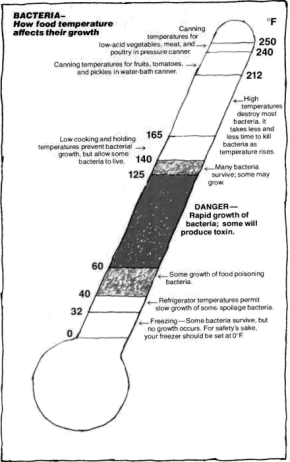

Bacteria are the one of the main food poisoners. So, to get food on the table safely, you need to know and follow the rules for food care.
KEEP FOOD HOT
High food temperatures (165°F to 212°F) reached in boiling, baking, frying, and roasting kill most food poisoning bacteria. If you want to delay serving cooked food, though, you have to keep it at a holding temperature — roughly 140°F to 165°F. Steam tables and chafing dishes are designed to maintain holding temperatures. But they don’t always keep food hot enough. So it’s not wise to leave hot food out more than 2 hours.
When cooked food is left out unheated, the possibility of bacterial growth is greater, since the food quickly drops to room temperature where food poisoners multiply.
To serve hot foods safely — particularly meat and poultry, which are highly affected by food poisoning — follow these rules:
• Cook thoroughly — Cook meat and poultry to the “doneness” temperatures given in the above chart. To make sure that meat and poultry are cooked all the way through, use a meat thermometer (温度计). Insert the tip into the thickest part of the meat, avoiding fat or bone.
• Don’t interrupt cooking — Cook meat and poultry completely at one time. Partial cooking may encourage bacterial growth before cooking is complete.
• Cooking frozen food - Allow frozen food more time to cook — generally 1.5 times the period required for food that has been thawed (解冻).
【小题1】At what temperature do bacteria grow the fastest?| A.40ºC~ 60ºC. | B.60ºF~125ºF. | C.40ºC~ 140ºC. | D.125ºF~140ºF. |
| A.hot food should not be left out over two hours. |
| B.frozen food should be thawed with a microwave oven. |
| C.raw ham should be cooked to the “doneness” temperature at 71ºF. |
| D.steam tables and chafing dishes should be used to keep food hot enough. |
| A.The only way to ensure food safety is to keep it hot enough. |
| B.High food temperatures above 74ºC destroy most poisoning bacteria. |
| C.Compared with goose, ground beef should be cooked to higher temperatures. |
| D.Insert the tip of a thermometer into the thickest part of the fat to control the temperature. |


